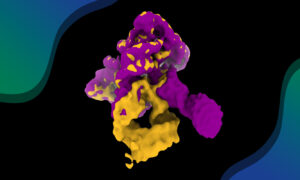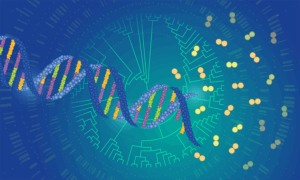
The curious case of the bi-specific enzyme
When Andrea Rentmeister from the University of Muenster came across an enzyme with curious bi-specific properties, she was eager to find out more about its molecular 3D structure. As a chemist with no expertise in protein crystalisation she turned to the Sample Preparation and Characterisation (SPC) facility at EMBL Hamburg for help. What started out as a shot in the dark, resulted in a crystal structure – shedding light onto this peculiar feature.

Curiosity created the crystal
“When I first learnt about the possibility of sending my samples to EMBL Hamburg, I was curious to give it a try,” Rentmeister says, recalling how she first heard about the services offered by the SPC facility. She wanted to learn more about the molecular structure of an enzyme found in cyanobacteria – a group of photosynthetic bacteria that can cause toxic blooms in lakes in the summer.
Specifically, Rentmeister was interested in one part of the multi-modular enzyme known as a nonribosomal peptide synthetase (NRPS). “NRPS enzymes are like assembly lines,” she explains. “They are made up of multiple domains, all needed to assemble a peptide chain: the first domain picks up an amino acid, a second hands it to a third domain that binds the amino acid to the next to form a peptide chain.” The first domain is usually specific to a single amino acid – only able to bind to one of the 20 common amino acids. “People have been bothered by this specificity for a long time,” says Rentmeister, “There are already several crystals structures of similar enzymes that show the binding ‘pocket’ for the amino acid.”
It’s intriguing that an enzyme can be specific to both Arginine and Tyrosine – structurally two very distinct amino acids.
“Scientists have generated a specificity code based on the residues found on the inside surface of this pocket, enabling us to predict which amino acid might bind with the enzyme,” continues Rentmeister. But this code is not 100% reliable and Rentmeister’s co-author, Guntram Christiansen from the University of Innsbruck, claimed to have found a domain that recognises not one, but two amino acids. “It’s intriguing that an enzyme can be specific to both Arginine and Tyrosine – structurally two very distinct amino acids,” Rentmeister explains. “We were puzzled: no one could explain how this was possible – maybe there is a second separate binding pocket?” Hence, her expedition into the world of structural biology, and to Hamburg to try to crystallise the curious enzyme and study its molecular structure on the EMBL beamlines at PETRA III.

A re-think
Rentmeister’s initial excitement was, however, short lived: “After a round of unsuccessful crystallisation experiments in 2011, I thought – ok, it was a nice experience, but no result.” Fortunately, at this time, SPC facility manager Rob Meijers started to offer a follow-up service to users who had failed to crystalise their proteins – people like Rentmeister. Meijers got in contact to suggest another round of experiments focusing on quality control and optimisation.
Crystallising a protein is not as easy as producing crystals from a solution of kitchen salt.
“Crystallising a protein is not as easy as producing crystals from a solution of kitchen salt – that’s why we decided to set up a service to help non-experts get the most out of their samples,” explains Meijers. “Now when we receive a sample, like this enzyme, we set up hundreds of experiments each a few nano-milliliters in volume with varying concentrations of buffers and salts to try to find the best conditions for crystallisation.”

Soaking it in
“Based on Rob’s feedback we re-designed the experiment and got nice crystals,” says Rentmeister. But, once again, enthusiasm was fleeting: the data from the beamline experiments did not allow the researchers to completely observe the part of the enzyme of interest – the part involved in amino acid specificity. Not to be beaten, Meijers’ then-PhD student Heidi Kaljunen started a series of ‘soaking’ experiments, drenching the crystals in solutions containing amino acid molecules so that the enzymes would bind to their specific amino acids, Arginine and Tyrosine. At last, the team succeeded in crystalising and resolving structures of the enzyme in combination with the two amino acids. Moreover, the structures showed that, once the amino acid has taken its place, the pocket is sealed off so that the amino acid can be bound to the peptide chain.
Contrary to Rentmeister’s initial theory – that the enzyme might have a second binding site – both amino acids are seen using the same pocket. “The most amazing thing is that if you superimpose the structures of the two amino acids bound to the enzyme, you see how the amino acid Arginine snuggles into the binding pocket pretending to be a Tyrosine,” she says. The crystal structures show how one end of the Arginine molecule curls in on itself, mimicking the structure of Tyrosine. “It was both interesting and disappointing, because the answer was so simple and logical!”

Pin-pointed
Having solved the mystery of the bi-specificity, however, the story didn’t end there. Rentmeister’s team did a number of mutation studies, creating mutants of the enzyme to identify exactly which of the residues in the enzyme was responsible for the bi-specificity. “We pin-pointed it to three residues,” she explains. “By changing these residues, we could create mono-specificity for Arginine or Tyrosine, which as far as we know is not found in nature.”
Reprogrammed NRPS enzymes could be used to produce novel peptides with interesting properties.
Looking at the structures of the two amino acids, Meijers wondered whether a so-called non-natural amino acid – 4-azidophenylalanine – could fit the pocket and be activated by the enzyme. “This man-made amino acid is a sort of chemical chimera of Arginine and Tyrosine,” he says. And, indeed, one of the mutant enzymes took up this non-natural amino acid. The results, published in Angewandte Chemie, point to several promising future research directions. “That the NRPS enzyme could accept non-natural amino acids and potentially incorporate them into the poly-peptide chain, opens up a number of exciting possibilities,” says Meijers. “For example, reprogrammed NRPS enzymes could be used to produce novel peptides with interesting properties.”
“It is also not really understood why these cyanobacteria produce toxic blooms in summer,” adds Rentmeister. “We can now design an amino acid to include a traceable tag and map cellular pathways and processes.”

Worth it
Rentmeister explains that the experience with the SPC team at EMBL Hamburg proved indispensable. “Bi-specificity has not been observed in this group of enzymes before Guntram’s work and now with the help of Rob’s team we have shown how this is achieved and how we might use this for protein engineering and synthetic biology approaches. It took a while, but it was worth it!” she concludes.
“Andrea is exactly the kind of person we want to support,” says Meijers. “As a non-expert, she came to us with an interesting structural biological question, which we helped to answer – this was a really exciting project to be part of.” Rentmeister is now keen to come back to EMBL Hamburg with more enzymes and has signed up to access the SPC facility via the latest transnational access project, BioStruct-X. “I’ll be back!” she says with a smile.


